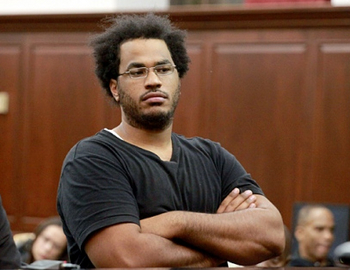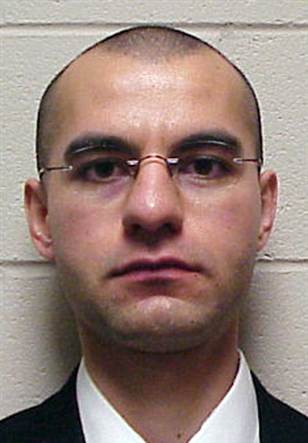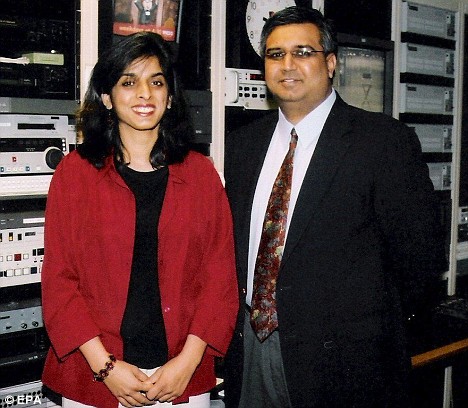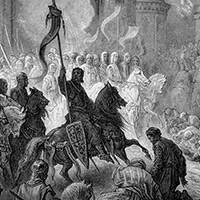![]()
Spring 2012 | Middle East Quarterly, Volume XIX: Number 2, pp. 3-13 | by Teri Blumenfeld

The absurdity of the current approach to jihadist trials can be seen in the case of Carlos Bledsoe. On trial for killing U.S. Army recruiter William Long, Bledsoe complained of undue pressure to plead insanity: "I wasn't insane or post-traumatic." The killing was "justified according to Islamic laws and the Islamic religion," Bledsoe wrote.
Muslims who kill in the name of their religion frequently evade punishment in Western courts by pleading insanity or mental incompetence. Jurors, judges, and forensic psychiatrists are prone to accept the claim that some form of mental incapacity, not religious belief, accounts for “homegrown” jihadist terrorism in North America and Europe.
This state of affairs results from the failure by prosecutors to frame acts of jihadist violence as expressions of faith. This failure to prosecute jihadists vigorously stems from several sources: a deep-rooted, Western reluctance to impugn religion; a cult of political correctness; and culturally naïve wishful thinking. Viewing jihadists as crazy offers a comfortable conceit that ignores the stark reality that disaffected but sane Muslims are seduced by an ideology that espouses violent hatred of Western civilization.
Lone Wolf Jihadists
Jihadism is a supremacist ideology that seeks to bring about the establishment of a global Islamic state and the application of Islamic law, the Shari’a. It relies both on political efforts and on acts of violence against “infidels.” According to terrorism specialist Steve Emerson’s review of Justice Department statistics,[1] radical Islamists account for more than 80 percent of all terrorist convictions in the United States since the 9/11 attacks.[2]
In the past, most jihadist violence was carried out by organized terror networks. Today, however, the most effective means of striking the United States is to convert and radicalize U.S. citizens and residents into carrying out terrorist attacks on their own. So-called “lone wolf” jihadists are typically radicalized through local, Islamic institutions and the Internet (chat rooms, blogs, social networking sites, etc.) where religious teaching, propaganda videos, and bomb-making directions are disseminated widely. Some go abroad for further instruction; others simply download a “how-to” manual.
Perhaps the most influential source of contemporary jihadist indoctrination was the late Anwar al-Awlaki, a U.S. citizen whose sermons have been directly linked to more than a dozen terrorist plots.[3] His message, which lives on in cyberspace, is simple:
We will implement the rule of Allah on earth by the tip of the sword. We need men who are willing to go all the way and not hold back anything from Allah. The religion of Allah cannot be given victory by part-time service. This is not a weekend religion. The contract is to sell our souls to Allah. The compensation is paradise.[4]
While the lone wolf jihadist usually acts alone from an operational standpoint, he is part of a well-defined, Internet-based pack whose killings are often meticulously premeditated. He may plan the attacks on his own, but he does so with the instruction, support, and direction of a greater community of radicalized Islamists — and with the tacit approval of a significant percentage of Muslims (well over ten percent by most estimates)[5] who admire Islamic terrorists. The Internet enables lone wolf jihadists to acquire the “networks of support and ideologies of validation”[6] that fuel their transformation into killers. The November 2009 massacre at Fort Hood by U.S. Army Maj. Nidal Malik Hasan, which left thirteen people dead and twenty-nine wounded, was apparently inspired by the defendant’s correspondence with Awlaki. Los Angeles-born al-Qaeda propagandist Adam Gadahn, known to have a powerful influence on converts, later stated:
The mujahid brother Nidal Hasan has shown us what one righteous Muslim with an assault rifle can do for his religion and brothers in faith and has reminded us of how much pride and joy a single act of resistance and courage can instill in the hearts of Muslims everywhere.[7]
In this, Hasan and his co-jihadists have succeeded, judging from the multitude of homegrown attacks on American soil that were foiled in 2011. Two American converts to Islam, Abu Khalid Abdul-Latif and Walli Mujahidh, were charged with “conspiracy to murder officers and agents of the United States.” Marine reservist Yonathan Melaku was indicted on charges of firing weapons at the Pentagon and other military sites in northern Virginia.[8] Army private Nasser Abdo was in the final stages of preparing another attack at Fort Hood when he was arrested.[9] Emerson Begolly was arrested for posting bomb-making instructions on the Internet and attacking federal agents while his house was being searched.[10] Khalid Aldawsari, a Saudi chemical engineering student, was arrested on charges of researching targets for attack, including the home of former president George W. Bush, and attempting to build a bomb.[11] Rezwan Ferdaus nearly succeeded in his plot to bomb the Pentagon and Capitol building.[12]
Legal Insanity and Mental Incompetence
There are two ways that a defendant who has undeniably killed or maimed someone without provocation can avoid prison — either win a verdict of not guilty by reason of insanity (NGRI) or be continuously judged mentally incompetent to stand trial, both of which have the practical effect of landing him in a psychiatric facility. Psychiatric facilities have obvious advantages over prison; besides the day-to-day relative comfort, these facilities offer the defendant the opportunity for periodic appeals to assess his sanity. In the case of Omeed Aziz Popal, who ran down sixteen pedestrians in San Francisco, he is entitled to a release hearing every two years. Popal seems to prefer life at a psychiatric facility: When he was transferred to Fremont prison pending separate charges for the murder of a local resident, he asked, “Is there any way possible I can go back to the Napa hospital.”[13] Yusef DeJarnette, who wounded two people in separate shootings, has been living in a psychiatric facility since he was deemed not guilty by reason of insanity. At a hearing, Northcoast Behavioral Healthcare recommended DeJarnette be placed in a group home: “If he is released, the judge would be able to monitor him and set the conditions of his freedom.”[14] Patrick Gott, a student of Islam whose actions briefly evoked fears of terrorism eight months after the 9/11 attacks, remains in state custody at the Feliciana Forensic Facility at Jackson. Doctors evaluate him regularly, and should they ever declare him sane and no longer a danger to himself and others, the law allows a judge to release him. Whether the jihadist appeals periodically to determine if he has recovered his “sanity” and hence tries for release, or the insanity plea results in superior living conditions, the salient issue is that jihadists are perceived as insane rather than driven by religious obligation in both the case law and public perception. This misperception is self-perpetuating, because as jihadists continue to be labeled insane there is consequently a lack of preventive action as a result of misidentification of the actual motive.
A diminished capacity or “partial insanity” defense can be used to argue that the defendant’s mental condition at the time of the crime merits a less serious charge or reduced sentence though it does not constitute grounds for acquittal. Hammad Samana in 2008 plotted to attack U.S. military, Israeli, and Jewish facilities in California. The lone Muslim-born member of his cell, his sentence was shorter than his three fellow cell members because he had a smaller role in the plot and suffered from mental health issues.[15] Samana was declared unfit to stand trial and was placed in psychiatric care. He was eventually sentenced to seventy months in 2009 but received less than half the sentence of the other cell members because of his mental condition. “In light of Samana’s mental health issues at the time of the offense, such a disparity is warranted and justified,” Judge Carney said.[16] Nadim Haque was declared not guilty of murder because he suffered from an abnormal condition of the mind. He was found guilty of manslaughter instead of murder because he acted “while under the influence of extreme anger… The theory behind these defenses was that Haque’s traditional Muslim Indian upbringing, immigrant experience, and psychological condition strongly influenced his perception.”[17]
Although definitions of legal insanity vary from country to country (and, in the United States, from state to state), virtually all require that a person be unable to distinguish between legal right and wrong. Under U.S. federal law, an insanity defense requires that “at the time of the commission of the acts constituting the offense, the defendant, as a result of a severe mental disease or defect, was unable to appreciate the nature and quality or the wrongfulness of his acts.”[18] Under federal legislation passed after John Hinckley, Jr.’s acquittal for shooting President Ronald Reagan, the burden of proof lies on the defense, which must show “clear and convincing” evidence of insanity. Hinckley enjoys unsupervised weekend furloughs as a result of his status hearings.[19] The living conditions within the facility’s pleasant grounds are eminently more desirable than a life in prison. As Hinckley described in a Penthouse magazine interview shortly after his arrival, on a typical day at St. Elizabeth’s [Hospital]: “I see a therapist, answer mail, play my guitar, listen to music, play pool, watch television, eat lousy food, and take delicious medication.”[20]
According to the U.S. Supreme Court, a defendant is competent to stand trial if he has “sufficient present ability to consult with his lawyer with a reasonable degree of rational understanding” and a “rational as well as factual understanding of the proceedings against him.”[21] Such determinations are made by court-appointed psychiatrists, not by juries.
While the late Supreme Court justice Benjamin N. Cardozo famously maintained that someone who sincerely believes that God instructed him to kill is ipso facto suffering from an insane delusion,[22] this so-called “deific decree” standard is not widely accepted. Although a case can be made that “someone who genuinely believes he has heard God’s voice command him to kill another… lacks the ability to reason about the moral quality of his action,”[23] this does not imply that he is unaware of its illegality or its consequences. Absent compelling corroborating evidence of schizophrenia or other severe hallucinatory disorders, claiming to have received divine or other supernatural instructions is not ordinarily sufficient to convince a jury to acquit.
It is also important to bear in mind that the horrific nature of a crime alone is not sufficient evidence of a “severe mental disease or defect” (otherwise, cannibalistic killer Jeffrey Dahmer would have been acquitted). Because of these constrictions, the insanity defense is employed in less than one percent of felony murder cases in the United States and is successful in only a quarter of those.[24]
Insanity Defenses by Jihadists
While there is little reason to believe that recognized terror group operatives are any less maladjusted than lone wolves, insanity defenses by the former are rare (and rarely succeed). This may be due to the political component ascribed to an acknowledged terror group member, whose actions can be understood as political in nature. Recognized terror groups are generally considered to be in political rather than religious conflict with the West, and there is, therefore, a disassociation when this “war” is waged by a lone “soldier of God.” Thus, it is the solitary, Muslim extremist taking it upon himself to carry out God’s will who tends to strike Western jurors, judges, and even forensic psychiatrists as crazy.
Most jihadists are too committed to their creed to plead insanity as this would be a rejection of the teachings that led them to commit murder. Zacarias Moussaoui, the convicted terrorist linked to the September 11 attacks, testified that he “rejects his court-appointed defense team’s theory that he is mentally ill.” Asked if he was crazy, Moussaoui said, “Thank God, I am not.”[25] Mohammed Bouyeri, Theo Van Gogh’s murderer, said at his trial in the Netherlands, “What moved me to do what I did was purely my faith. Islam compels me to cut off the head of anyone who insults Allah and the Prophet.”[26] Times Square bomber Faisal Shahzad warned: “Brace yourselves, because the war with Muslims has just begun. Consider me only a first droplet of the blood that will follow me.” The 31-year-old Pakistani immigrant justified his plot in the name of Islam, saying that “the Koran gives us the right to defend, and that’s all I’m doing.”[27]
Defense attorneys are eager to magnify any history of mental illness, no matter how tenuous, in seeking to gain acquittals, avoid trial, or win reduced sentences for their jihadist clients. They will cite mental instability,[28] depression,[29] lack of medication,[30] post-traumatic stress disorder, hearing voices,[31] and delusions of persecution[32] to name a few.
Not guilty by reason of insanity: Although jihadists who plead insanity may have some history of mental illness, or at least a host of relatives testifying to it, this alone is not sufficient evidence of innocence. Even when a radical Islamist who goes on a murderous rampage happens to be a diagnosed schizophrenic, it does not necessarily follow that he was legally insane in commission of the act — it could be that his ideology drove him to it even if his illness initially facilitated the underlying radicalization.
In principle, evidence of jihadist indoctrination should render an insanity plea untenable because it puts forth a compelling, presumed motive that the defense is obliged to disprove with “clear and convincing” evidence. This is very difficult to do even if the defendant has a history of mental illness. A crack addict with schizophrenia who kills someone in the course of a robbery will have a hard time disproving that crack addiction was the motivational driver unless the prosecution omits or downplays the fact that the defendant is a crack addict.
In practice, jihadists have repeatedly fared well[33] and won acquittals even when there is substantial evidence of ideological motivation.
- In 2002, Nabil Ouldeddine was found not guilty by reason of insanity (NGRI) for stabbing an Orthodox Jew twenty times on a London bus. Although he later told psychiatrists that the voice of a woman named Jennifer commanded him to kill, the reason he gave to the police officers who arrested him was far more prosaic: “Israel are [sic] the murderers. They kill women and children, so I stabbed him.”[34]
- In 2003, Yusef DeJarnette was found NGRI for wounding two people in a series of random shootings from his bicycle in Shaker Heights, Ohio. In his home, police found writings conveying his hatred of white people, a poster of Osama bin Laden, and books about making gun silencers. He was clear-headed enough to avoid capture until police traced the bullets back to him.[35]
- In 2008, Omeed Aziz Popal was found NGRI for injuring sixteen pedestrians with his SUV in a long rampage that ended outside the Jewish Community Center of San Francisco. Mike Mahoney, the police inspector who investigated the case, scoffed at the acquittal: “He knew exactly what he did. He told me exactly what he did.”[36]
- In 2005, Muslim convert Patrick Gott was found NGRI for opening fire inside a New Orleans airport, killing one woman. Gott, who carried a Qur’an and chanted “Allah!” during the shooting, later told police he was enraged when someone made fun of his turban.[37] Although the defense produced evidence of severe mental illness, their argument that this illness led him to commit the crime was weak. Two forensic psychiatrists testified only that “it is more likely than not” that Gott was “psychotic, delusionally paranoid, and experiencing auditory hallucinations at the time of the shooting,”[38] hardly meeting the burden of proof normally required of the defense.
The insanity defense is not always allowed by judges. In 2009, Muzzammil S. “Mo” Hassan beheaded his wife after she filed for divorce. He later claimed that he was emotionally “out of control” when he killed her. He requested and underwent psychiatric examination, but the judge in the case ruled that his lawyers could not use an insanity defense due to the delay by the defense in presenting their case.[39]
The Fort Hood killer’s civilian defense lawyer, John P. Galligan, initially said that an insanity defense was under consideration although it was never clear whether Hasan himself was willing to make such a plea.[40] However, Galligan backed off after a three-member military mental-health panel evaluated Hasan and details of his methodical preparations in the months before the massacre came to light. “That much planning implies he had a clear understanding of his actions and he understood the consequences,” said Anthony Ng, former president of the American Association of Emergency Psychiatry. “It’s possible to be mentally ill [and] still be held liable for your actions if you’re aware of the consequences.”[41]
Incompetent to stand trial: Winning a ruling of incompetence to stand trial has the same practical result as an NGRI verdict — the defendant is confined to a psychiatric facility. The facts of the case are not relevant — the defendant’s mental state at the time of evaluation is at issue.
- In 2009, Hammad Samana was declared unfit to stand trial on charges of plotting to attack U.S. military, Israeli, and Jewish facilities in California. He is now in psychiatric care.[42]
- In 2010, a Paris court ruled for the second time that Adel Amastaibou is a paranoid schizophrenic and unfit to stand trial for sadistically stabbing his neighbor to death in 2003.[43] “I have killed my Jew. I will go to paradise,”[44] Amastaibou declared to police after the murder.
Diminished capacity defenses: Diminished capacity or responsibility defenses are typically used to cast doubt on whether the defendant acted with premeditation and intent to kill. Such defenses can result in conviction on lesser charges.
- In October 2010, a judge sentenced Hosam Smadi to twenty-four years in prison for attempting to blow up a downtown Dallas skyscraper — less than the thirty years allowable under his plea agreement with prosecutors — after hearing defense testimony that he suffered from schizophrenia.[45]
- In 2007, Bosnian war veteran Asim Cejanovic attempted to smuggle a bag filled with explosives into the U.S. embassy in Vienna. Under interrogation, he fingered Mehmed Djudjic, who had long-standing ties to Wahhabi, jihadist circles in Bosnia, for giving him the backpack.[46] On the first day of his trial, Cejvanovic declared that he had important information about Wahhabi extremists that he wished to “offer” the United States.[47] However, taking note of Cejvanovic’s psychiatric treatment for posttraumatic stress disorder, the judge ruled that there was insufficient evidence to convict him of plotting to bomb anyone as his frequent telephone and e-mail contact with the embassy prior to the incident was “not a typical strategy for somebody who tries to enter the U.S. embassy to detonate a bomb.”[48] The court sentenced him to fifteen months in prison for illegal possession of explosives.
- In 2008, Khalid Alzghoul brutally beat nine people with a hammer at a Vancouver gay-pride march while screaming, “This is judgment day!”[49] After his history of mental illness was raised in court, Alzghoul was acquitted of hate-crime charges and sentenced to two and half years in jail for simple assault.
- In 2005, Jordanian-born Ali Warrayat drove his car into a Home Depot, blasting Arabic music with a Qur’an and a Palestinian flag in the trunk, hoping to set fire to the flammable goods department. After a court-appointed doctor diagnosed Warrayat with schizophrenia, he was sentenced to just five years in prison.[50]

A deep-rooted, Western reluctance to impugn religion may be behind the aversion of prosecutors to raise ideology in the trials of jihadists. In 2006, Mohammed Reza Taheri-Azar cited the Qur’an as the reason he drove an SUV into a crowd of people at the University of North Carolina-Chapel Hill. Such admissions should make an insanity plea untenable.
The insanity plea strategy does not appear to work as well if the defendant is uncooperative. In 2006, Mohammed Reza Taheri-Azar said that the Qur’an gave him permission to drive a jeep into a crowd of people at the University of North Carolina-Chapel Hill, injuring nine, so as “to punish the U.S. government, the enemy of my brothers and sisters in religion.”[51] Taheri-Azar’s lawyer pleaded for leniency on the grounds that “a severe mental illness” affected his actions,[52] but the defendant’s lack of remorse led the judge to give him the maximum possible sentence.
Overzealous Defense, Under-zealous Prosecution
Although each of the above legal strategies hinges on different judicial actors (juries, forensic psychiatrists, and judges, respectively), all three have proven successful for jihadist defendants. So much so, in fact, that jihadists have a legitimate gripe about the U.S. judicial system — they are coming under undue pressure from public defenders to plead insanity.
This was evident in the case of Carlos Bledsoe, a convert to Islam who now calls himself Abdulhakim Muhammad.[53] Bledsoe opened fire on a military recruiting station in Arkansas, killing one soldier and wounding another. After his capture, he promptly confessed to carrying out what he called a “jihadi operation” and later offered to plead guilty to murder charges.
Astonishingly, his lawyers refused his request, and the judge ruled that he was not mentally competent to make the decision himself. Legal pundits explained that it would not “make sense” for a mentally competent defendant to plead guilty to capital murder charges.[54] Interestingly, he was not ruled mentally unfit to stand trial — he was considered legally competent except for his desire to claim responsibility for murder in the name of God. Bledsoe’s lawyers decided to mount an insanity defense over his objections and called to the witness stand forensic psychiatrist Shawn Agharkar, who testified that the defendant suffered from delusions of grandeur and persecution.[55]
Bledsoe protested vehemently, insisting that the shooting was an act of war and claiming loyalty to al-Qaeda. “I wasn’t insane or posttraumatic, nor was I forced to do this act,” Bledsoe wrote to the judge, adding that it was “justified according to Islamic laws and the Islamic religion.”[56] While Bledsoe was ultimately allowed to plead guilty in exchange for prosecutors dropping their demand for the death penalty, the spectacle of a defendant being forced to disown his ideological convictions and mount an insanity defense is striking.
While the proclivity of lawyers for jihadists to mount mental-illness defenses is troubling, this in itself is not the problem. Criminal defendants are entitled to a vigorous defense under U.S. law, and this is exactly what their lawyers have striven to do. More troubling is why lawyers are succeeding. There is little particularly new or imaginative about their arguments — they have been effective because jihadists have not been subjected to spirited prosecution as a recognized group of offenders.
Time and again, prosecutors have failed to position jihadist defendants within a larger community of like-minded extremists carrying out similar acts around the world even though defendants frequently affirm their jihadist motivations during their attacks (particularly with the trademark phrase “Allahu Akbar!” or “God is great!”), upon arrest, while incarcerated, or in the course of court proceedings. In addition, they often have Islamist indoctrination material in their on-line presence or among their possessions. These identifying elements constitute the characteristics of the syndrome.
The two trials of Naveed Haq underscore how important this can be to the jury’s verdict. In July 2006, Haq gunned down six people at the offices of the Jewish Federation of Greater Seattle, killing one. In prison telephone calls to relatives, he later said he was “proud” of the murderous rampage, calling himself “a soldier of Islam” and “a martyr” who is “going to go to heaven.”[57] When Haq’s lawyers put forth an insanity defense in his first trial, prosecutors chose not to present the recorded calls as evidence, apparently fearing that they would make Haq sound crazy and support the insanity plea. The jury deadlocked, and a mistrial was declared. However, when this evidence was presented in his second trial, Haq was convicted.[58] When jurors are informed of the context in which a jihadist attack is perpetrated, they are more likely to reject an insanity plea. “The jury held that holding extremist views does not make you insane, but it does make you dangerous,” victim Carol Goldman stated at a news conference after the verdict.[59]
Public Misperceptions
Deprived of relevant information about the acquired radicalization and virtual socialization underlying jihadism, jurors and judges alike are more prone to accept insanity pleas. The brutality of these crimes and the pursuit of heavenly rewards that motivate them seem crazy. Who in his right mind would kill people indiscriminately? Juries are rarely asked to consider whether the behavior they are evaluating fits a pattern exhibited by thousands of others in the same on-line community. Likewise, prosecutors and judges are reluctant to dwell on the religious beliefs of defendants. The First Amendment protects the free exercise of religion and implies that courts are not allowed to consider whether a person’s religious beliefs are false.[60] However, the architects of the U.S. Constitution likely never envisioned that religion would one day be used by an identifiable segment of a population to attack Americans. While aggressive prosecution of jihadists can hardly be considered a threat to the free exercise of religion, it, nevertheless, is at odds with how some policymakers in Washington choose publicly to frame the Islamist threat.

In February 2009, Muzzammil Hassan, CEO of Bridges TV, intended as a media outlet for moderate Muslims, beheaded his wife who had filed for divorce. His claim of being emotionally “out of control” when he killed her was dismissed by the judge. As Anthony Ng, former president of the American Association of Emergency Psychiatry wrote, “It’s possible to be mentally ill (and) still be held liable for your actions if you’re aware of the consequences.” (Photo: EPA)
In its zeal to avoid the appearance of impugning Islam, the Obama administration adopted a new national security policy, two years in the making, which uses the general term “violent extremists” to avoid emphasis on the threat posed by radical Islam.[61] The Department of Homeland Security’s secretary Janet Napolitano replaced “terrorism” with “man-caused” disasters[62] while the administration’s national security strategy replaced the term “Islamic terrorism” with “violent extremism.”[63] In May 2010, Attorney General Eric Holder’s acrobatic refusal to concede during a congressional hearing that radical Islam might be a factor fueling homegrown terrorism became a minor YouTube hit.[64]
This reframing is reflective of a broader trend in the mainstream media. The official guidelines of the American Society of Professional Journalists recommend “avoid[ing] using word combinations such as ‘Islamic terrorist’ or ‘Muslim extremist'” and suggest defining jihad as the desire “to exert oneself for the good of Islam and to better oneself.”[65] The effect of such guidelines is to scrub public discussion of the jihadist threat.
Fearful of reinforcing the “Muslim terrorist” stereotype, reporters often minimize the religious component of violent actions by Muslims and ignore evidence of Islamist indoctrination. This was particularly evident after the Fort Hood massacre. “I cringe that he’s a Muslim… I think he’s probably just a nut case,” Newsweek‘s Evan Thomas said of Hasan.[66] Joe Klein of Time magazine decried attempts to argue that the massacre “was somehow a direct consequence of his Islamic beliefs.”[67] In the words of Warren Richey, a Christian Science Monitor staff writer, the “only apparent connection between Abdo and Hasan is that they are both Muslim-Americans who served in the U.S. army.”[68] This attitude makes it ever more challenging to identify cases.
Such commentaries display a strong subtext of wishful thinking. No one wants to believe that any sane Muslim serving in the U.S. army was radicalized through on-line socialization with al-Qaeda into massacring his comrades. Many refuse to accept that “a true American, [who] plays football, helps his grandmother and mows the lawns of his neighbors,” as Bledsoe was described by his lawyer,[69] could radicalize to the point of murdering U.S. servicemen without being crazy.
Law enforcement, hampered by bad policies and fear of profiling, assumes (or at least publicly maintains) that religion is incidental to crime. As a Seattle FBI agent explains, “Ideology is less important than action… it does not matter if it is Christian identity or radical Islam. We have to focus on these guys committing crimes.”[70] Of course, Christian extremists are not carrying out terror attacks the world over. Despite concerns about antiabortion violence by Christian fundamentalists in the United States, such attacks accounted for only nine deaths since 1970 (all of the perpetrators were convicted; none pled insanity).[71] In contrast, it is estimated that 51,319 people have died at the hands of Islamic terrorists in the past seven and a half years alone, and more than 84,323 have been injured.[72]
Unfortunately, juries are not asked to consider whether the behavior they are evaluating fits a pattern exhibited by thousands of others in the same worldwide community. Only when the jihadist is a member of a known terror group will this commonality be recognized and the insanity defense rejected since it is perceived as a hostile, political act rather than an expression of religious belief.
Whether stemming from ignorance, political correctness, or wishful thinking, these misperceptions effectively efface a critical element of investigating and punishing crime–motivation. If law enforcement intends to ignore the motivation, commonalities, and shared characteristics of jihadist attacks, it cannot possibly hope to prevent them. If jurors are not informed of such things, they cannot deliver impartial justice.
Conclusion
Michael Leiter, National Counterterrorism Center director, has bemoaned al-Qaeda propaganda “designed to inspire like-minded individuals to conduct attacks in their home countries,”[73] but this begs the question of what made them “like-minded” in the first place. The vast majority of those who answer this call are not crazy; they are radicalized.
Melvin Bledsoe shed a great deal of light on the indoctrination of his son Carlos in recent testimony before the House Homeland Security Committee.[74] Carlos converted to Islam and changed his name after going off to college in Nashville (hardly a hotbed of terrorism) and frequenting local mosques in the fall of 2003. On visits home, he tried to convert members of his family, even tearing down Martin Luther King’s picture from the wall. In 2005, his family visited him, only to find that he had dropped out of school and turned his dog loose in the woods, claiming that the animal was considered impure under Islamic law.[75]
Bledsoe blamed his son’s radicalization on Muslim groups in Nashville that converted him and facilitated his travel abroad, as well as the culture of political correctness that allows Islamists to organize freely so long as they abide by the letter of the law. “Fear of stepping on a special minority population’s toes, even as a segment of that population wants to stamp out America and everything we stand for,”[76] is what radicalized Carlos, he testified. It is this fear that drives the misguided efforts of media and politicians to rationalize jihadist acts as born of insanity.
U.S. policymakers’ strenuous efforts to deny that radical Islam is a driver of jihadist violence have served only to compromise the American people’s right to thorough investigation and vigorous prosecution of those who threaten their security. As homegrown terror plots continue to proliferate in the years ahead, law enforcement must be trained to recognize the telltale signs of jihadist radicalization and freely report their findings to the public while prosecutors must not shy away from putting the belief systems fueling the violence on trial. The legal definition of insanity should be changed to exclude more explicitly those who are indoctrinated to believe that God wants them to murder innocent men, women, and children.
Teri Blumenfeld is a researcher with the Middle East Forum and with the Department of Justice for terror fundraising trials.
![]()
Notes:
[1] “Statistics on Unsealed International Terrorism and Terrorism-Related Convictions,” U.S. Department of Justice, Washington, D.C., accessed Jan. 5, 2012.
[2] “Islamists Dominate DOJ’s List of Terror Prosecutions,” Investigative Project News, Mar. 9, 2011.
[3] The New York Times, Oct. 10, 2011.
[4] “In the Name of Allah,” TheReligionofPeace.com, accessed Jan. 5, 2012.
[5] Daniel Pipes, “Counting Islamists,” DanielPipes.org; Oct. 8, 2008; Arutz Sheva (Beit El and Petah Tikva), Sept. 12, 2011; al-Arabiya (Dubai), Sept. 12, 2011.
[6] Mark Juergensmeyer, Terror in the Mind of God: The Global Rise of Religious Violence (Berkeley: University of California Press, 1999), chap. 1.
[7] The Christian Science Monitor (Boston), Oct. 19, 2010.
[8] WTOP FM (Washington, D.C.), July 25, 2011.
[9] ABC News, July 29, 2011.
[10] Fox News, Aug. 2, 2011.
[11] FBI news release, U.S. Department of Justice, Washington, D.C., Feb. 24, 2011; Fox News, Feb. 25, 2011.
[12] ABC News, Sept. 29, 2011.
[13] Oakland (Calif.) Tribune, Sept. 1, 2006.
[14] The Plain Dealer (Cleveland), Dec. 5, 2008.
[15] YNet News (Tel Aviv), Mar. 6, 2009.
[16] The Orange County Register (Santa Ana), Aug. 17, 2009.
[17] State v. Nadim Haque, Maine Supreme Judicial Court, Portland, Feb. 16, 1999.
[18] U.S. Code – Title 18: Crimes and Criminal Procedure, Sec. 17. Insanity Defense.
[19] “Biography: John Hinckley, Jr.,” American Experience, Public Broadcasting Service, accessed Jan. 10, 2012.
[20] “John Hinckley at St. Elizabeth Hospital: Still Seeking His Freedom,” University of Missouri-Kansas City School of Law, accessed Jan. 10, 2012.
[21] Dusky v. United States, 362 U.S. 402, United States Court of Appeals for the Eighth Circuit, St. Louis, no. 504, misc., Apr. 18, 1960.
[22] Ralph Slovenko, Psychiatry in Law/Law in Psychiatry (London: Routledge, 2009), p. 191; “Terrorism Trials and the Constitutionality of the Religious Insanity Defense,” Prawfsblawg blog (Fla.), Jan. 6, 2010.
[23] Morris B. Hoffman and Stephen J. Morse, “The Insanity Defense Goes Back on Trial,” The New York Times, July 30, 2006.
[24] “Insanity Defense FAQs,” Frontline, Public Broadcasting Service, accessed Jan. 5, 2011.
[25] CNN, Apr. 14, 2006.
[26] “In the Name of Allah,” TheReligionofPeace.com, accessed Jan. 5, 2012.
[27] The New York Post, Oct. 6, 2010.
[28] Le Journal de Montréal, June 14, 2007; “Montreal Muslim Who Killed His Ex-Muslim Brother: All Those Who Are Not Muslims Are Satan,” Jihad Watch, trans., June 14, 2007.
[29] “Minneapolis Carjacker Mentally Ill, Suffers from Depression and Hasn’t Being Taking His Medication,” Jihad Watch, Feb. 1, 2007.
[30] Daniel Pipes, “More Incidents of Denying Islamist Terrorism,” DanielPipes.org, updated Aug. 7, 2009.
[31] The Times Picayune (New Orleans), May 20, 2005.
[32] Local London, Apr. 8, 2005; Air Force Times, May 20, 2005; Free Republic (Fresno), July 11, 2005; CBS News, Feb. 11, 2009.
[33] “Insanity Defense FAQs,” Public Broadcasting Service, accessed Jan. 16, 2012.
[34] The Guardian (London), Sept. 18, 2002.
[35] The Plain Dealer (Cleveland), Dec. 3, 2003.
[36] The San Francisco Chronicle, Aug. 1, 2008.
[37] Associated Press, May 23, 2002.
[38] The Times Picayune, May 20, 2005.
[39] The Buffalo News, Sept. 19, 2009, Aug. 13, 2010.
[40] The New York Times, July 20, 2011.
[41] Medscape News, Nov. 5, 2010.
[42] Agence France-Presse, Mar. 9, 2009.
[43] YNet News (Tel Aviv), Jan. 5, 2010.
[44] The Jerusalem Post, Jan. 21, 2010; Mark Steyn, “Needing to wake up, West just closes its eyes,” The Chicago Sun-Times, Feb. 26, 2006.
[45] “Failed Dallas Bomber Is Latest in a Long Line of Jihadists Claiming Mental Illness While on Trial,” Jihad Watch, Oct. 20, 2010.
[46] Anes Alic, “Investigation into Backgrounds of Bosnians Involved in Vienna Plot,” Terrorism Focus (Jamestown Foundation, Washington, D.C.), Oct. 12, 2007.
[47] “Vienna Court Sees No Terrorism Plot against U.S. Embassy,” U.S. Embassy, Vienna, Apr. 9, 2008, released by Wikileaks, Aug. 30, 2011.
[49] Xtra! (Vancouver), Nov. 19, 2009.
[50] The Arizona Republic (Phoenix), Oct. 24, 2006.
[51] The News and Observer (Raleigh), Mar. 16, 2006.
[52] Ibid., Mar. 6, 2007.
[53] The Huffington Post (New York), July 25, 2011.
[54] The New York Times, Jan. 22, 2010.
[55] Associated Press, July 22, 2011.
[56] The New York Times, Jan. 22, 2010.
[57] “Crazy for Jihad,” The Washington Times, Dec. 17, 2009.
[58] Ibid.
[59] United Press International, Dec. 16, 2009.
[60] First Amendment, U.S. Constitution.
[61] “Empowering Local Partners to Prevent Violent Extremism in the United States,” White House, Washington D.C., Aug. 2011.
[62] Der Spiegel (Hamburg), Mar. 16, 2009.
[63] Stuart Gottlieb, “War on Terror: Obama Softened the Language But Hardened Muslim Hearts,” The Christian Science Monitor, Oct. 14, 2010.
[64] Eric Holder, testimony before the U.S. House Judiciary Committee, Washington, D.C., May 13, 2010.
[65] “Guidelines for Countering Racial, Ethnic and Religious Profiling,” Society of Professional Journalists, Indianapolis, Oct. 6, 2001.
[66] Charles Krauthammer, “Medicalizing Mass Murder,” The Washington Post, Nov. 13, 2009.
[67] Joe Klein, “Bigoted Religious Extremists,” Time Magazine, Nov. 7, 2009.
[68] The Christian Science Monitor, July 29, 2011.
[69] CNN, June 5, 2009.
[70] The Seattle Times, June 25, 2011.
[71] Associated Press, May 31, 2009; Global Terrorism Database, University of Maryland, College Park, Md., accessed Jan. 16, 2012.
[72] Total numbers obtained from Worldwide Incidents Tracking System (WITS), National Counterterrorism Center, Washington, D.C., for the period Jan. 1, 2004-Sept. 30, 2011, accessed Jan. 16, 2012; “Islamic Terror on American Soil,” TheReligionofPeace.com, accessed Jan. 7, 2012.
[73] Dan Lungren, “A Matter of Congressional Oversight,” U.S. House, Washington, D.C., Mar. 10, 2011.
[74] Melvin Bledsoe, testimony before the Committee on Homeland Security, U.S. House of Representatives, Washington, D.C., Mar. 10, 2011.
[76] The New York Daily News, Mar. 13, 2011.



 RSS
RSS










[…] exposure of TERRORISM and NATIONAL SECURITY HomeAbout Apr 12 2012 Leave a comment […]